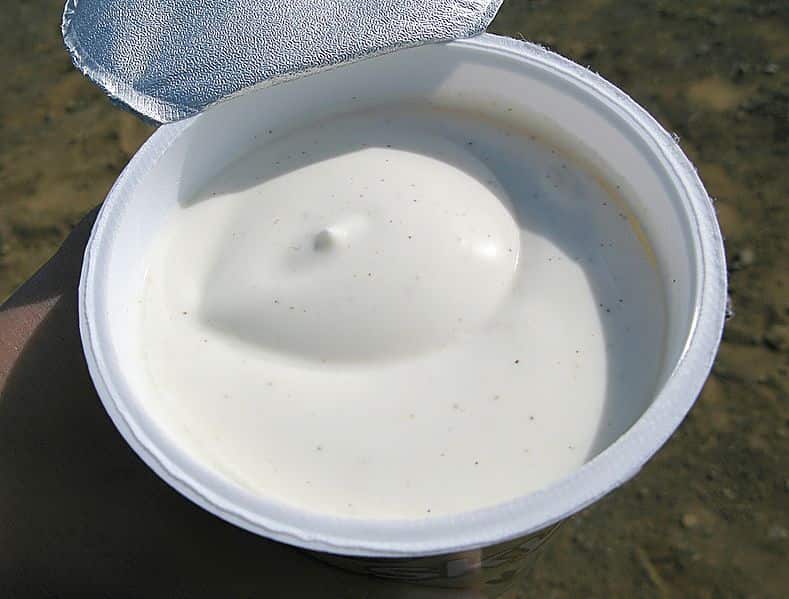Skyr is a dairy staple of Icelandic cuisine—rich, creamy, and packed with protein. Similar to curd cheese, it’s made from skimmed milk and live cultures and consumed like yogurt. Read on to learn more about this Icelandic treat.
If you’re visiting Iceland, trying skyr is a must. Whether eaten plain, mixed with berries and honey, or blended into smoothies and desserts, it’s a delicious way to taste Icelandic heritage. But what makes skyr different from yogurt or sour cream? How is it made, and why has it gained popularity beyond Iceland’s shores?
Why You Can Trust Our Content
Guide to Iceland is the most trusted travel platform in Iceland, helping millions of visitors each year. All our content is written and reviewed by local experts who are deeply familiar with Iceland. You can count on us for accurate, up-to-date, and trustworthy travel advice.
Keep reading to learn everything about skyr, from its Viking origins to its modern-day appeal. We’ll share our favorite ways to enjoy it and where to get the freshest skyr in Iceland, whether from a local grocery store, farm-sourced, or even as part of Icelandic food and drink tours.
And if you’d like to explore even more of Icelandic culture, you can choose from a wide variety of vacation packages in Iceland, many of which include culinary experiences alongside sightseeing.
Key Takeaways
-
Technically Cheese: Skyr looks and tastes like yogurt, but it’s actually cheese made with live cultures and rennet.
-
High Protein, Low Fat: This thick, creamy dairy staple is packed with protein and made from skim milk, making it both filling and nutritious.
-
A Viking-Era Superfood: Skyr has been part of Icelandic cuisine for over 1,000 years and is still widely enjoyed today.
-
Versatile & Delicious: Eat it plain, sweetened with fruit and honey, or use it in smoothies, baking, and even savory sauces.
-
Available Worldwide: While nothing beats trying it in Iceland, you can now find authentic or Icelandic-style skyr in stores across the US, UK, and Europe.
What Is Skyr?
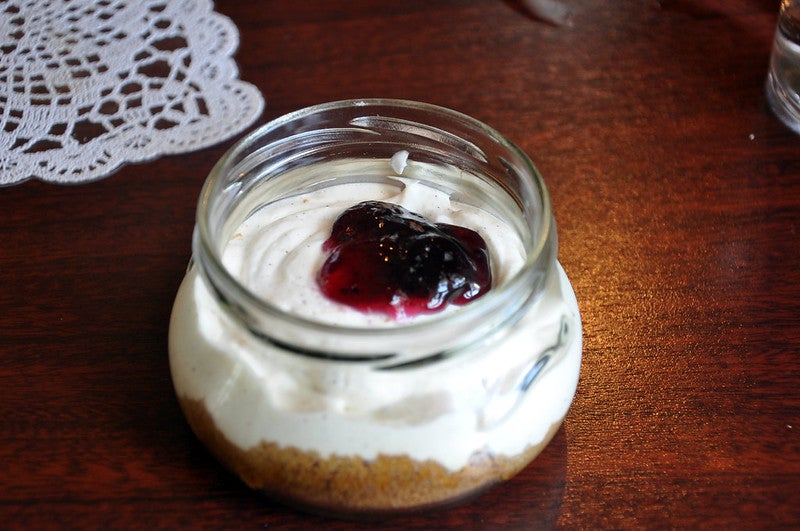
Photo by Jennifer Boyer.
Skyr, pronounced like “skeer,” is a traditional Icelandic dairy product with a thick, creamy consistency and a mild, slightly tangy flavor. At first glance, it might seem like just another yogurt—especially since it’s often compared to Greek yogurt—but skyr is actually a type of cheese, made using a unique straining process that sets it apart.
Despite its classification as cheese, skyr is smooth and spoonable, much like a dense, velvety yogurt. Subtle tartness balanced by a naturally mild flavor makes it easy to enjoy on its own or paired with fruit, honey, or even savory ingredients. Unlike some tangier yogurts, skyr’s delicate taste appeals to a wide range of palates.
This ancient dairy treat has been a staple in Icelandic cuisine for centuries, providing a nutritious and delicious source of protein for generations. But what exactly goes into making skyr, and how does it differ from regular yogurt?
A Dairy Tradition Rooted in Viking History
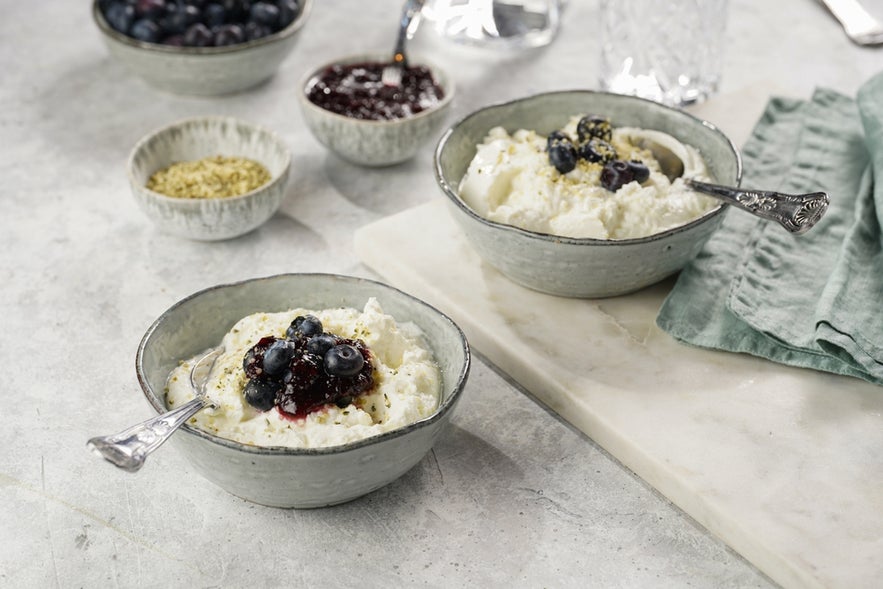 Skyr has been a cornerstone of Icelandic cuisine since the Viking Age. Brought to Iceland by Norse settlers in the 9th century, this high-protein dairy product remained a staple in the Icelandic diet, helping hardy pioneers survive the harsh North Atlantic climate.
Skyr has been a cornerstone of Icelandic cuisine since the Viking Age. Brought to Iceland by Norse settlers in the 9th century, this high-protein dairy product remained a staple in the Icelandic diet, helping hardy pioneers survive the harsh North Atlantic climate.
Unlike many other traditional foods that faded over time, skyr remained essential to Icelandic food culture.
References to skyr appear in medieval Icelandic literature, including the Sagas of Icelanders, where it was mentioned as a common food source. These early texts describe skyr being stored in wooden barrels and enjoyed as a nutritious meal by farmers, travelers, and warriors.
Featured less in Scandinavian diets, skyr remains deeply embedded in Icelandic culinary traditions, passed down through generations. For a glimpse into skyr’s long history, you can even visit the National Museum of Iceland, where three jars of fossilized skyr are on display.
Where To Try Skyr in Iceland
 If you want to taste the real thing while exploring Iceland, you’ll find skyr everywhere from supermarket shelves to gourmet restaurants.
If you want to taste the real thing while exploring Iceland, you’ll find skyr everywhere from supermarket shelves to gourmet restaurants.
A fantastic way to try Icelandic food is on a food tour in Reykjavik. A three-hour walking tour of Reykjavik will let you explore Iceland's vibrant capital city and taste traditional Icelandic food like skyr.
You can also find skyr in every grocery store across Iceland, including popular chains like Kronan, Bonus, and Netto. It’s often stocked in multiple flavors, from classic plain and vanilla to berry, mango, coconut, and more. Even gas stations carry single-serving tubs—perfect for a healthy snack during a road trip.
Here are a few great places to try it in Reykjavik and beyond:
-
Islenski Barinn (The Icelandic Bar) – Reykjavik: A cozy spot in downtown Reykjavik that offers traditional Icelandic dishes, often featuring skyr as part of dessert or as a side.
-
Efstidalur Farm – Near the Golden Circle: This family-run farm offers homemade skyr straight from the source. You can even see the cows that produce the milk while enjoying a scoop of skyr in their dairy cafe.
-
Erpsstadir Creamery – West Iceland: A small-scale dairy farm offering tours and tastings of artisan skyr and ice cream. It’s a great stop on a road trip through the Snaefellsnes Peninsula or toward the Westfjords.
-
Cafe Loki – Across from Hallgrimskirkja: Known for its traditional Icelandic menu, Cafe Loki serves a sweet skyr mousse topped with rye bread crumble—a must-try twist on the classic.
- Looking for budget-friendly food tips? Check out our guide on how to eat well in Reykjavik without breaking the bank.
How Is Skyr Made?
Skyr is traditionally made from skimmed cow’s milk, which gives it a surprisingly thick and creamy texture despite its low fat content. After separating the cream, the milk is heated to about 165°F (73°C) for 15 to 20 seconds, then cooled to around 99°F (37°C)—the ideal temperature for fermentation.
Next, producers add a live culture (often from a previous batch), and sometimes rennet, to help the milk thicken. After five hours of fermentation, the mixture is cooled to 65°F (18°C) and strained to remove the whey.
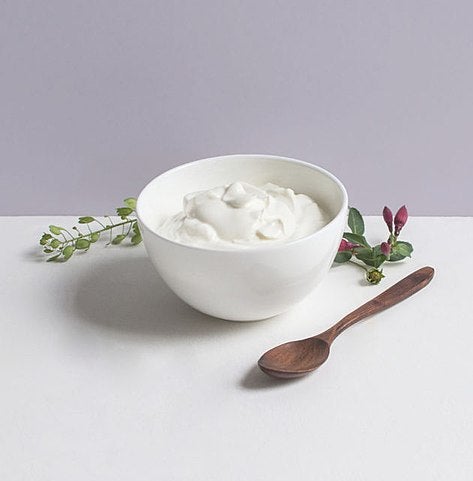
Photo by IcelandicProvisions, from Wikimedia, Creative Commons. No edits made.
This final step gives skyr its signature thick, smooth texture. It takes around four cups of milk to make just one cup of skyr, which explains its rich, protein-packed consistency.
While traditional skyr is plain and fat-free, you’ll also find flavored versions—like vanilla, berry, or tropical blends—and even full-fat varieties for an extra creamy treat.
Skyr Versus Yogurt: What’s the Difference?

Photo by Chris and Sue.
Skyr looks just like yogurt. It’s sold in similar tubs, found in the same grocery store aisle, and even comes in familiar flavors. But while they may seem alike, skyr and yogurt have a few key differences that set them apart.
Both skyr and yogurt are made using live bacterial cultures, which ferment the milk and give the final product its tangy flavor. However, Skyr is made with bacterial cultures and rennet—an enzyme that helps milk form curds—making it a cheese, not yogurt.
Another big difference is the milk used. Yogurt is traditionally made with full-fat milk, while skyr is made with skim milk, giving it a naturally lower fat content while maintaining a thick, creamy texture.
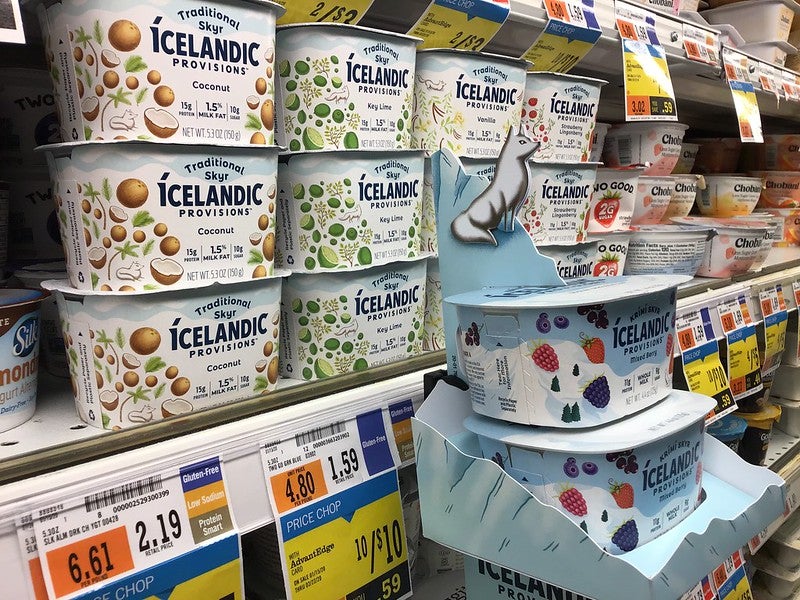
Photo by Mike Mozart.
The result? Skyr is often thicker, higher in protein, and lower in fat than regular or even Greek yogurt. Although Greek yogurt is commonly made with cow’s milk outside of Greece, it’s traditionally produced with sheep’s milk, while skyr has always been made from cow’s milk in Iceland.
So next time you see a tub of skyr, don’t be fooled—while it may sit next to yogurt on the grocery shelf, this Icelandic classic belongs in a delicious category of its own.
Is Skyr Healthy? Nutritional & Dietary Facts

Photo by Lynn Friedman.
Skyr isn’t just delicious—it’s also full of nutritional value. Here’s what you should know about its nutrition, probiotics, and dietary suitability.
Skyr’s Protein and Low-Fat Benefits
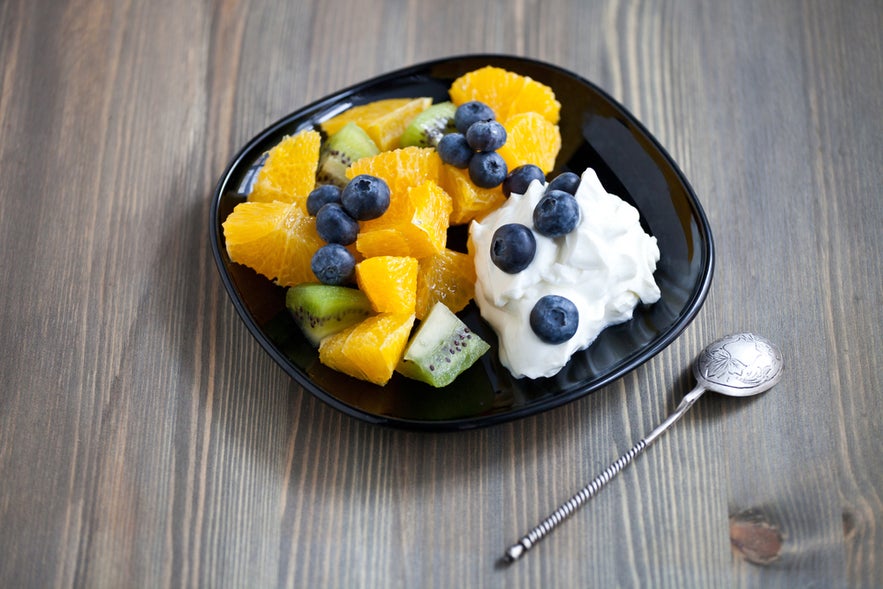 Skyr is a naturally protein-rich food, making it a favorite among athletes, hikers, and health-conscious travelers. A typical 7-ounce (200-gram) serving contains about 24 grams of protein and less than 1 gram of fat, thanks to its skim milk base. It’s also a great source of calcium and B vitamins, both important for bone health and energy metabolism.
Skyr is a naturally protein-rich food, making it a favorite among athletes, hikers, and health-conscious travelers. A typical 7-ounce (200-gram) serving contains about 24 grams of protein and less than 1 gram of fat, thanks to its skim milk base. It’s also a great source of calcium and B vitamins, both important for bone health and energy metabolism.
Gut-Friendly Benefits of Skyr
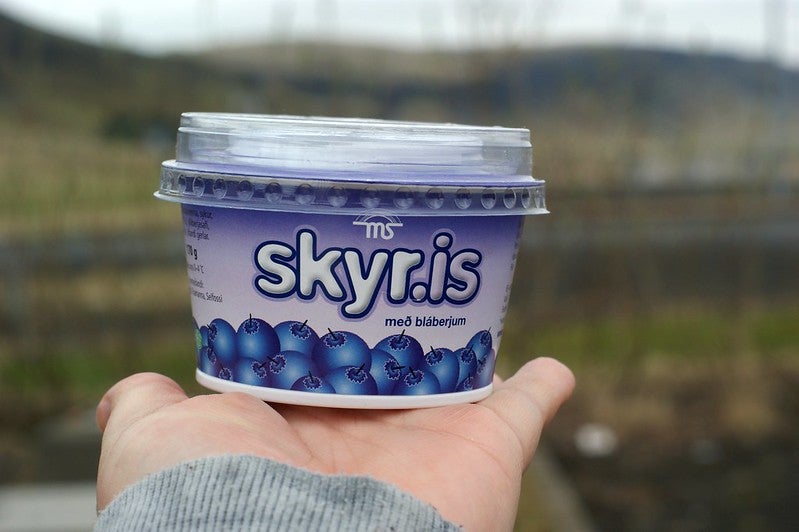
Photo by omgponies2.
As a fermented dairy product, skyr contains live probiotics, which may support digestive health by helping balance gut bacteria. Many people enjoy it as a gentle food when recovering from illness or taking antibiotics. While scientific research on the health impact of probiotics is still evolving, skyr has long been considered a nourishing, stomach-friendly food in Iceland.
Skyr for People With Lactose Intolerance

Photo by Rakka.
Many people with mild to moderate lactose intolerance can tolerate skyr. Up to 90% of the lactose is removed during the fermentation and straining process. However, those with a severe intolerance or milk allergy should consult a healthcare provider or avoid skyr altogether.
Skyr Vegetarian-Friendly Options
Photo by Schnee, from Wikimedia, Creative Commons. No edits made.
Skyr is made with cow’s milk and rennet, an enzyme traditionally derived from animal sources. That means not all skyr is suitable for vegetarians. However, some producers use plant-based rennet, making their skyr vegetarian-friendly.
Here’s a quick tip:
-
KEA (Icelandic Provisions) skyr is made with animal rennet—not vegetarian-friendly.
-
Isey Skyr uses plant-based rennet—vegetarian-approved.
Unfortunately, Icelandic producers aren’t required to list the type of rennet on their packaging. If you follow a strict vegetarian diet, your best bet is to contact the brand directly or stick with Isey products.
How To Eat Skyr
 In Iceland, skyr is an everyday staple—most often enjoyed at breakfast but also eaten throughout the day as a snack, dessert, or even a savory side. While it can be eaten plain, many Icelanders like to sweeten it with sugar, mix in fresh berries, or top it with granola, oats, or dried fruits. A bowl of skyr with oatmeal is a classic Icelandic breakfast that’s filling and nutritious.
In Iceland, skyr is an everyday staple—most often enjoyed at breakfast but also eaten throughout the day as a snack, dessert, or even a savory side. While it can be eaten plain, many Icelanders like to sweeten it with sugar, mix in fresh berries, or top it with granola, oats, or dried fruits. A bowl of skyr with oatmeal is a classic Icelandic breakfast that’s filling and nutritious.
Skyr is also a popular ingredient in baking and cooking. It can be used in everything from cheesecake fillings to creamy sauces, dips, or as a tangy substitute for mascarpone or sour cream.
Thanks to its high protein content and low fat, skyr keeps you full for hours—one reason it’s so popular among hikers, busy families, and anyone needing sustained energy during Iceland’s active lifestyle.
Skyr Around the World
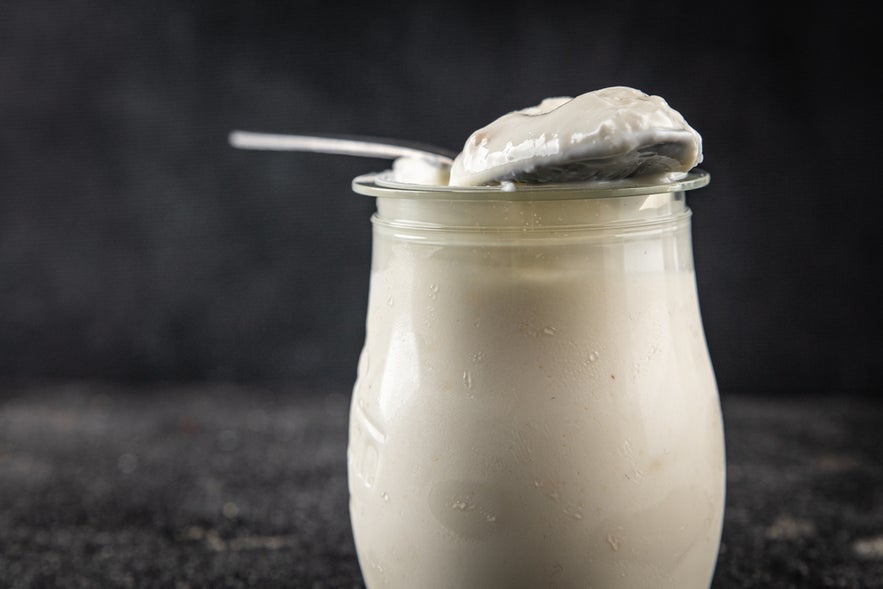 For centuries, skyr was uniquely Icelandic, surviving long after it vanished from the rest of Scandinavia following the Viking Age. But in recent years, its reputation as a high-protein, low-fat superfood has made it a hit abroad.
For centuries, skyr was uniquely Icelandic, surviving long after it vanished from the rest of Scandinavia following the Viking Age. But in recent years, its reputation as a high-protein, low-fat superfood has made it a hit abroad.
Today, you can find skyr in grocery stores across the US, UK, and parts of Europe, often stocked alongside Greek yogurt. While international brands produce skyr-style products, true Icelandic skyr, like Isey Skyr and KEA, remains the gold standard.
It’s now common to find skyr in supermarkets worldwide, so you don’t have to be in Iceland to try it. However, buying from Icelandic producers or companies with strong Icelandic roots is a good idea if you want the most authentic taste.
-
Icelandic Provisions is a US-based brand, but their skyr is made in partnership with MS Iceland Dairies, the oldest farmer-owned dairy in Iceland.
-
Siggi’s, founded by Icelandic native Siggi Hilmarsson, produces skyr in the traditional Icelandic style and is widely available in American and European grocery stores.
-
Arla, a major Scandinavian dairy company based in Denmark, also makes Icelandic-style skyr for sale in Denmark and the UK. Arla is one of the largest dairy producers in Europe.
Some farms in Iceland, like Efstidalur and Erpsstadir, even offer the chance to taste fresh, locally made skyr right at the source—a delicious way to connect with Iceland’s living food traditions.
Frequently Asked Questions About Skyr
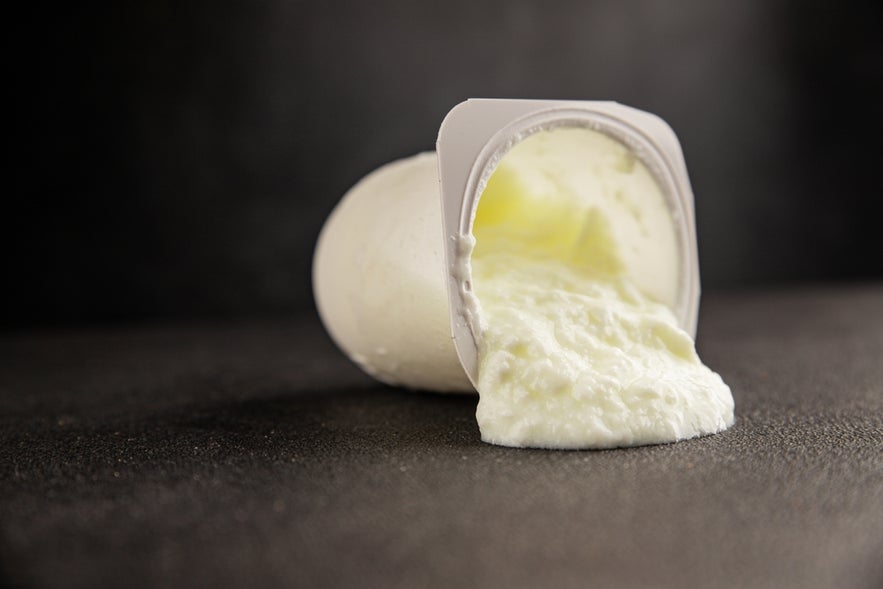 Curious about skyr? Here are some answers to common questions travelers and food lovers ask.
Curious about skyr? Here are some answers to common questions travelers and food lovers ask.
What does skyr taste like?
Skyr has a mild, slightly tangy flavor—somewhere between Greek yogurt and cream cheese—with a thick, velvety texture. Flavored versions (like vanilla, berry, or mango) are lightly sweet and especially popular with kids and travelers trying it for the first time.
Can I make skyr at home?
Yes, it’s possible to make skyr at home if you have access to quality skim milk, live skyr cultures (or a starter from plain store-bought skyr), and a bit of patience. You’ll need to heat, culture, and strain the milk—similar to homemade yogurt—and ideally use cheesecloth for the final step to achieve the right consistency.
How long does skyr last in the fridge?
Unopened skyr usually lasts one to two weeks past the “best by” date if refrigerated. Once opened, it’s best consumed within five to seven days. Always check for changes in smell or texture before eating.
Is skyr safe to eat during pregnancy?
Yes, as long as it’s made with pasteurized milk, skyr is considered safe during pregnancy. It can be a great source of calcium and protein for expecting parents. Always check the label or ask the producer if you’re unsure.
Can skyr be frozen?
Yes, but freezing can alter its creamy texture. If you freeze it (for example, in a smoothie pack), it’s best used in blended recipes rather than eaten plain.
A Taste of Iceland in Every Spoonful
 Whether you’re a foodie, a health enthusiast, or simply curious about Icelandic culture, skyr is a must-try during your visit. Its creamy texture, gentle flavor, and impressive nutritional profile have made it a staple in Icelandic kitchens for over a thousand years—and now, it's winning hearts around the world.
Whether you’re a foodie, a health enthusiast, or simply curious about Icelandic culture, skyr is a must-try during your visit. Its creamy texture, gentle flavor, and impressive nutritional profile have made it a staple in Icelandic kitchens for over a thousand years—and now, it's winning hearts around the world.
From a quick breakfast with berries to a luxurious dessert mousse, skyr is as versatile as it is delicious. We hope this guide gives you everything you need to know about skyr—what it is, how it’s made, and where to find the very best of it while you're in Iceland.
Have you tried skyr before? What flavor is your favorite—or are you planning to try it for the first time in Iceland? Let us know in the comments below!

